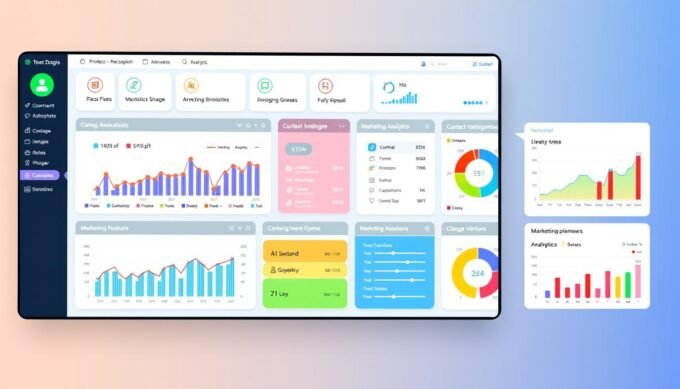In the world of tech, things are always changing. This is why Go High Level API Documentation is so important. It helps developers fully integrate with this evolving platform. With new updates, like OAuth 2.0 and API 2.0, developers get access to latest features. Keeping up with these changes is essential. The Go High Level API guide is here to help. It turns complex developer resources into practical advice.
Right now, API 1.0 is still in use. But, the shift towards API 2.0 is clear. This new version will have more features. The Developers Landing Page is where you find everything about Go High Level. It includes a special Developer Marketplace, lots of documentation, and a Slack channel for chatting and help. For anyone into Go High Level development, joining the monthly Developer Council Call is a must. It’s where you stay in touch with new updates and the community.
Key Takeaways
- Go High Level API 1.0 is stable, with no new endpoints planned, but its successor, API 2.0, is rapidly progressing.
- A daily limit of 200,000 requests ensures ample room for robust API interactions within both versions.
- Understanding the ‘X-RateLimit’ HTTP headers is crucial to effectively monitor and stay within permitted usage parameters.
- Depending on your subscription plan, Basic or Advanced API access will vary, with the Agency Pro plan unlocking advanced features.
- The significance of a regular review of the Go High Level API documentation cannot be overstated, enabling seamless adaptation to the latest integrations.
- Engagement with the Go High Level community through the Developer Council Call and Slack groups paves the way for collaborative innovation and problem-solving.
- Remembering that security is paramount, leveraging the robust protocols and best practices outlined in the API guide will stand you in good stead.
Introduction to Go High Level API
I started to explore the Go High Level API and found it quite impressive. It has strong capabilities that support innovation and make workflows smoother. It is a key player in marketing automation and management. The Go High Level API provides Go High Level integrations, many Go High Level API endpoints, and options for Go High Level API usage. These features help improve marketing strategies and business operations.
Let’s first understand what Go High Level really is as we dive into its functionalities.
What is Go High Level?
Go High Level is a full package for digital marketing agencies and businesses. It offers everything from CRM, marketing automation, to communication solutions. With APIs like Data, Metadata, Auth, and Uploads, it meets various digital marketing needs. The wide range of Go High Level integrations gives developers the tools to build customized solutions. These improve efficiency and expand market presence.
Benefits of Using the API
Using the Go High Level API has big benefits. It offers advanced custom options and better data handling. This leads to more effective campaign management and client interactions. For developers, getting to know and use Go High Level API endpoints opens up new possibilities. They can create special functionalities that meet current market needs.
| API | Description | Access |
|---|---|---|
| Data | Handles customer and campaign data | Agency Level |
| Metadata | Provides settings and configurations | Sub Account Level |
| Auth | Manages authentication and security | Agency Level |
| Uploads | Deals with file uploads and storage | Sub Account Level |
To learn more about improving your digital marketing tools using the Go High Level API, check out this detailed guide: documentation available here. It’s a great resource for boosting your project’s effectiveness with Go High Level API usage.
Getting Started with the API
Welcome to the Go High Level API’s exciting world. Opportunities are just a few codes away. Let’s start this journey to unlock the Go High Level API’s huge potential.
Creating Your Account
Creating your account is the first step with the Go High Level API. This step lets you access many tools and resources. They’re vital for anyone wanting to use or integrate the Go High Level API. Signing up is fast. It only needs basic info to begin on the developer platform.
Accessing the API Documentation
After your account is ready, the next big step is accessing the Go High Level API’s tutorials and documentation. Here, you’ll find detailed guides and an intuitive API Explorer. They make your code work easier. The API documentation helps you understand the API’s basic and complex parts. It makes sure you can use its features accurately.
If you’re looking to upgrade your platform smoothly, the migration guide from ActiveCampaign to HighLevel provides important details on moving data. It aims at making this process smooth.
The Go High Level API reference comes in two main versions. You should use the API 2.0 documentation for new development work. Doing this ensures your work stays current with HighLevel’s latest tech breakthroughs. Here’s a brief of what you usually find in the Go High Level API documentation:
| Feature | API 1.0 | API 2.0 |
|---|---|---|
| API Key Availability | Yes, Under Agency Settings | Yes, Agency Level |
| Rate Limits | 200,000 daily requests | 200,000 daily requests, plus limits per Marketplace app |
| Planned Obsolescence | Yes, transitioning out | No, future of API |
| End Point Integration | Partial | Expanding |
To improve your coding skills and integration with the Go High Level API, start with the right setup and understanding of the documentation. Whether you’re new and excited about API possibilities or an expert wanting to use HighLevel’s features, you have what you need.

Authentication Methods
In today’s digital age, keeping API interactions safe is more important than ever. For those using Go High Level API, knowing how to protect user data is essential. We’ll cover some basic methods that are crucial for developers.
API Keys: What You Need to Know
API keys are a starting point for new developers. These keys are unique identifiers for each user. They help you access what the API offers. It’s important to keep each key a secret to stop unauthorized use. This follows Go High Level API’s best advice.
API keys are the first step in securing your online work. They make sure every API request is checked and allowed properly.
OAuth 2.0: A Quick Guide
OAuth 2.0 goes beyond API keys to offer stronger security. It’s used by big names like Google APIs and services. Go High Level API has also adopted OAuth 2.0. This approach lets services use resources for a user, without giving away passwords.
Using OAuth 2.0 cuts down on security risks. It controls what third-party apps can do. This is a key part of making Go High Level API use safe and efficient.
Adding these security steps to your apps boosts safety and improves how you use Go High Level API. It helps whether you’re dealing with user data directly or working on backend tasks. Good security is crucial for making the most of the API.
Understanding API Endpoints
Learning the Go High Level API is key to using its powerful features. Each endpoint is a portal allowing actions like getting data or running commands. Knowing how to use these endpoints is crucial for developers.
Overview of Available Endpoints
The world of API technology changes fast. For devs, keeping up with Go High Level API updates is vital. It ensures their work stays compatible and ready for new changes. Reviewing the Go High Level API reference regularly is smart. It keeps their skills sharp and avoids the risks of using outdated info.
Commonly Used Endpoints
Some endpoints of Go High Level are used more than others. They’re key for tasks like getting user info or updating accounts. Knowing these through the Go High Level API reference is important. It helps devs make apps that are strong and offer great experiences for users.
- Data Retrieval: Enabling access to necessary data stored on Go High Level.
- Account Management: Used for updating user accounts and managing user data effectively.
- Integration Points: Facilitates seamless integration with other applications or services.
Using these endpoints well allows devs to create impactful, high-performing apps. This taps into Go High Level’s advanced features effectively.
Making API Requests
To work with the Go High Level API, it’s important to know how to send API requests. This is key whether you’re adding payment gateways or creating apps. Beginners can find detailed help in Go High Level API guides. These cover sending various request types and handling their responses.
GET Requests Explained
GET requests gather data from the Go High Level API. You might pull info on user actions, payment updates, or settings. Here’s how it works: you send a GET request to a specific endpoint. Then, the API gives back the data you asked for. This makes GET requests a basic tool in using Go High Level API.
POST Requests in Action
POST requests in Go High Level API help create or change resources. For example, to add a new payment option, you’d send a POST request. This includes all needed details, like your apiKey and publishableKey. Following the right steps improves your API use and app’s running.
Handling Responses from the API
After sending GET or POST requests, you have to manage the responses. This includes successful results and any errors or surprises. The API gives feedback for each request. This contains status codes and headers that aid in fixing issues for a smooth integration.

Handling responses from Go High Level API well is key. This involves understanding error messages, using successful payment notifications, or adjusting apps after POST feedback. Correct management makes your application more solid and dependable with the API.
Using structured methods with Go High Level API makes development easier. It also boosts your applications’ effectiveness. Always use Go High Level API tutorials to refine your integration. This will bring better performance and security.
Error Handling
When you use Go High Level API, knowing how to tackle errors is key. Handling errors does more than fix issues. It makes your Go High Level integrations solid and smooth for users. Let’s explore common errors and ways to fix them.
Common Errors and Solutions
Keep your app reliable by always checking for errors. Each error, from client or server side, tells you why good management is essential. Here are tips for handling different errors:
- Client Errors (4xx): Use HTTP response codes like 400 or 404 to tell users what went wrong. Make sure these messages are clear.
- Server Errors (5xx): With server issues, hide sensitive info. Use standard message formats and log them for your IT team.

Error handling relies on good documentation. Providing detailed error guides helps developers and users fix and understand problems.
Best Practices for Smooth Operation
For Go High Level integrations to work well, follow these tips:
- Error Logging: Keep a record of errors to help solve bugs and upgrade performance.
- Clear Error Response Structure: Use a consistent way to report errors. This makes it easier for developers to solve problems.
- Protect Sensitive Information: Be careful with server error messages. Don’t reveal important details.
- Regular Review and Updates: Always check and update your error handling. This helps you deal with new issues or changes.
By following these practices for Go High Level API, you’ll see fewer problems. This also makes systems more reliable and users happier. Remember, managing errors well keeps your API ahead by turning issues into chances for better service.
Webhooks: How They Work
Webhooks are crucial for real-time data sharing between apps, according to the Go High Level API guide. They use HTTP callbacks to send automated messages or actions when certain events happen. For example, they help connect Go High Level with tools like Stripe or Mailgun, making operations smoother and faster.
Setting Up Webhooks
Setting up webhooks involves knowing about Inbound and Outbound types. Inbound lets Go High Level get data from other apps. Outbound sends data to external systems. You start with a webhook URL, which is key for sending or receiving information. It’s also important to keep this URL secure to protect your data.
- Identify the Triggering Event: Choose the specific event in your workflow to start the webhook. It could be when a new customer signs up or makes a payment.
- Configure the Webhook URL: Set the destination for your HTTP requests in the Go High Level API.
- Set Up Payload: Decide the data to send or receive. For Inbound Webhooks, state what information, like email or phone numbers, is needed for your tasks.
Once ready, webhooks work quietly behind the scenes. They help integrate and automate your digital tools effortlessly.
Examples of Webhooks in Action
An eCommerce site uses Go High Level webhooks to update CRM with every new sale. It does this through an Inbound Webhook:
| Step | Process | Details |
|---|---|---|
| 1 | Retrieve Webhook URL | Get the unique URL from Go High Level dashboard for data reception. |
| 2 | Configuring Data Reception | Choose the specific data (like customer name, order details) the eCommerce site can send. |
| 3 | Mapping and Integration | Connect the received data to the right places in the CRM. |
| 4 | Action Activation | Use the data to do things like send a welcome email or start a follow-up task. |
Webhooks also enable instant alerts. For instance, they can notify a sales team in Slack or update project management tools when new contacts are added. This automation not only saves time but ensures data within business processes is current and accurate.

Working with Contacts
Managing contacts well is key for any digital marketing plan. The Go High Level API is very important here. It helps businesses improve how they manage contacts. This makes sure all customer info is current and easy to find. Moreover, using Go High Level API makes it easy to add or update contacts. This is vital for engaging with customers well.
Adding New Contacts via API
It’s easy to add new contacts with the Go High Level API. This fits well with your current systems. Businesses can automatically add contact info from their websites or other places where they talk to customers. This avoids mistakes from typing things in by hand. It’s great for businesses that want to grow their list of customers fast and well.
Updating Existing Contacts
The Go High Level API also makes it easy to update contacts you already have. You can change their details, add notes, or update how they want to hear from you. This means your contact list stays useful for talking to customers in a personal way. It’s good for marketing and talking to customers.

In the end, Go High Level’s integrations through its API make managing contacts simpler. They also make customer relationships better by keeping a database that’s always up to date. Adding these tools to your marketing can make your business run smoother. It can also make your communication strategies work better.
Managing Campaigns
Effective campaign management widens your marketing reach. It also boosts engagement and conversion rates. Using the Go High Level API makes this easier, letting you create scalable and efficient campaigns.
With Go High Level integrations, marketers can tap into many features. These features make operations smoother and strengthen digital strategies.
Overview of Campaign Management
The Go High Level API offers an easy-to-use setting for developers. They can set up and manage campaigns effortlessly. This access is key for handling campaign details well.
It ensures every part of campaign management is covered. This leads to better customization and adaptability.
Creating and Launching a Campaign
Creating a campaign requires careful steps. These steps can be better managed with Go High Level integrations. It’s important to follow Go High Level API best practices for success.
Integration with platforms like Salesforce and HubSpot is helpful. It makes managing contacts easier and expands your campaign’s reach. Setting up the right configurations ensures secure and effective API use.
- Advanced webhook configurations by Campaign Refinery boost campaign features.
- Integration with Salesforce and HubSpot helps manage campaigns better.
- Zapier’s vast integration options offer endless possibilities for campaigns.
Integrating various tools with your main campaign system is key. It creates a smooth workflow that helps reach marketing goals faster. This makes Go High Level integrations vital for digital marketing today.
Data Security Best Practices
When you manage sensitive data through Go High Level API, you need strong security measures. These practices help protect your API keys and user data. Let’s look at ways to make your projects more secure.
Ensuring Your API Keys Are Safe
Keeping your API keys safe is very important. They let you access your service. To protect them, you should:
- Store API keys in a place separate from your application code.
- Change your API keys often to reduce the risk of unauthorized use.
- Teach your team to keep API keys confidential.
Protecting User Data
Keeping user data safe is crucial for trust and legal reasons. To do this, you can:
- Encrypt sensitive user data, whether it’s being sent or stored.
- Check your security regularly to find and fix weaknesses.
- Make sure only authorized people can access data.
Using Private Integrations also makes distributing your system safer than traditional API keys. They are limited to developer use and work on the safer, more advanced API v2.0. This version supports important features like webhooks.
Here’s a brief on how API security and Private Integrations make managing safer:
| Feature | Details |
|---|---|
| API Version | Private Integrations use API v2.0, which is more secure and functional than API v1.0. |
| Token Rotation | Rotate tokens for Private Integrations every 90 days for the best security. |
| Access Control | You can change permissions like name and description without updating the token. |
| Management | Private Integrations let administrators manage user levels, offering control over sub-accounts. |
Adopting these practices will greatly improve the security of your Go High Level API use. This ensures your API keys and user data are protected from cyber threats.
Conclusion and Resources
I hope our deep dive into the Go High Level API was helpful and interesting. We looked at its cool features, like the easy-to-use page builder and smart automation with AI. Go High Level is a powerful tool for marketing and sales. It’s key for developers to keep learning from the many tutorials available.
Where to Find More Information
For those wanting to stay up-to-date, diving into Go High Level’s developer resources is key. The platform offers a lot, from building websites to managing communications. Thankfully, the Gohighlevel API Docs have all you need to master the API.
Community Support and Forums
The Go High Level community is a great place for learning together. By talking with other developers in forums and the Go High Level Developer Slack Channel, you’ll find tons of support and new ideas. It’s all about coming together, sharing skills, and making better user experiences.
FAQ
What is Go High Level?
What are the benefits of using the Go High Level API?
How do I create a Go High Level account?
Where can I access the Go High Level API Documentation?
What do I need to know about API keys in Go High Level?
What is OAuth 2.0, and how is it used in Go High Level?
What are the common endpoints available in Go High Level API?
How are GET requests used in the Go High Level API?
What are POST requests, and how do they work with the API?
How should I handle responses from the API?
What are some common errors in the Go High Level API, and how can I solve them?
What are the best practices for smooth operation with the Go High Level API?
How do I set up webhooks with Go High Level?
Can you give examples of webhooks in action with Go High Level?
How do I add a new contact via the Go High Level API?
What is involved in updating existing contacts with the API?
How do I ensure my API keys are secure with Go High Level?
What are the best practices for protecting user data through the Go High Level API?
Where can I find more information about Go High Level API?
Are there community support and forums for Go High Level developers?
Source Links
- HighLevel API
- GoHighLevel Api
- GoHighLevel review: How to connect to GoHighLevel API
- How to get started with the Developer's Marketplace
- Developing new connector for GoHighLevel API as a source
- Unlock the Power of GoHighLevel: A Guide to the API Documentation
- Explore the APIs of Clixlo and GoHighLevel (OAuth 2.0 API)
- Authentication methods at Google
- API Documentation: How to Write, Examples & Best Practices | Postman
- What is an API? A Beginner’s Guide to APIs | Postman
- How to build a custom payments integration on the platform
- How to Use Webhook.site to Troubleshoot your API Requests
- REST API Error Handling in Go: Behavioral Type Assertion
- API error handling: definition, example, best practices
- How to Use Webhooks in HighLevel (Zapier)
- How to use the Inbound Webhook Workflow Premium Action?
- Integration with Lead Conector (Go High Level)
- Bulk Importing Contacts Via CSV Walkthrough
- Solutions
- Custom Webhook Setup in GoHighLevel
- What Is The GoHighLevel API and How to Use it in 2023! – Shane Duggan
- Highlevel Security and Compliance Overview
- Private Integrations: Everything you need to know
- Gohighlevel Api Docs: Unlocking Advanced Integration Potential
- GoHighLevel – It’s time to take your Agency to the Next Level













